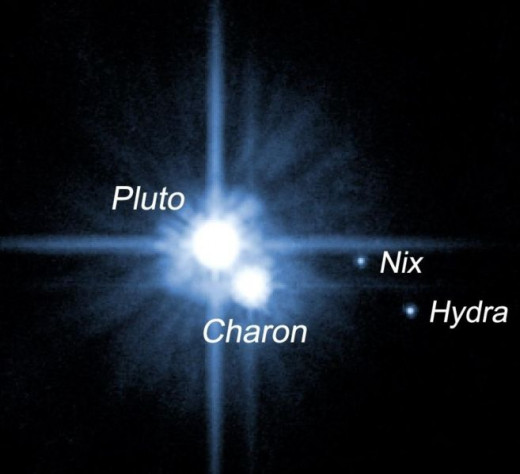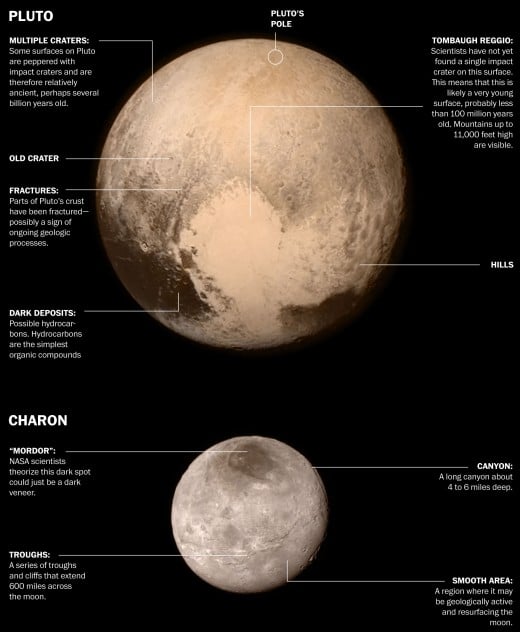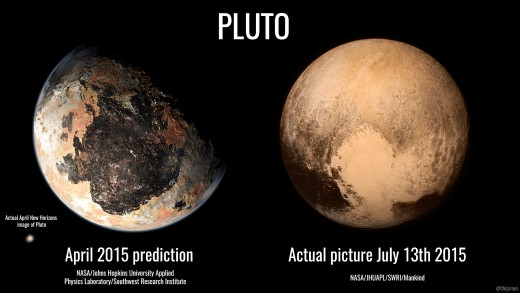Ten Amazing Facts about Planet Pluto

Everyone knows that the name is the Roman God Pluto of the underworld. However, most are unaware that Pluto got its name from an 11 year old girl in England. The theory is that Pluto is the god of the underworld and the planet is equally dark due to its distance from the sun. That is just the beginning of this awe-inspiring planet.
10. Pluto is not a planet
The great Pluto debate of 2006 took Pluto out of the planet club. He can no longer play all the other planet games anymore. He is considered a dwarf planet and not even the most massive of the dwarf planets. Unfortunately for Pluto, Eris theoretically is either the same size or possibly larger. It is the 10th largest body orbiting the sun. Fortunately, people with hearts of gold have decided that Pluto will always have a home in our solar system. When they did that, they decided to invite all the other dwarf planets we’ve been neglecting for decades.
This historical change means there are no longer 9 planets in the solar system. The official statement is that there are 8 planets. The astronomers removed Pluto forever, however, Pluto is not alone they added Five other dwarf planets. The official statement is now, 8 planets, 5 dwarf planets and only one partridge in a pair tree. (Pear trees may or may not have been mentioned in the listing).
9. Clyde Tombaugh loved Pluto, but loved E.T more
Clyde Tombaugh is the man most people have credited for the discovery of Pluto in 1930. Tombaugh was a poor man with a big dream. Some could even say he is an inspirational man who got to live his dream. He got hired at the observatory by sending drawings of Jupiter and Mars he saw from his homemade telescope. During the time of discovery, he found the Kuiper belt, and hundreds of asteroids.
Additionally, he was very ‘sci-fi’ minded. He, on repeated occasions, would call for serious investigation into the research of Unidentified flying objects, or UFO’s. He believed they were out there, and it is hard to dismiss a man who spent his entire life looking into and teaching masses of people about space. He documented several of them, but never as extraterrestrial ships, but more as extraterrestrial bodies of science. He said later (paraphrased) that he does believe there is life out there, but the science needs to be there to answer the questions, and how could we say there is nothing without research.

8. Pluto was planet X
Planet X! It sounds so Sci-fi people want to write books and screenplays about it. However, that was the original name of our infamous Pluto. Percival Lowell a dedicated astronomer first sighted the planet way back in 1840 without help from any friends on Facebook; just his friend William Pickering helped him discover it
He had been searching desperately for the trans-Neptunian planet for a while, and as technology increased so did the ability to find how amazing the solar system is. The hippest thing to do at the time was to talk about planets and education since the internet hadn’t shown them how important cats are yet.
7. Percival Lowell and William Pickering originally found Pluto
Percival Lowell and William Pickering did more than just discover there was a trans-Neptunian object Pluto. They are the men who manned the first extensive study to map Pluto in 1894. Their funding and effort was to detail the planet they called “X”. They were able to map Pluto’s orbit in 1909 and created an observatory (Lowell observatory) that Tombaugh made headlines for discovering it. They had pictures of it from 1906. Lowell observatory furthered the discoveries of the solar system in the future.
The more amazing part of the discovery was because the technology was not up to Google map standards they found the planets by the area is displaced, not by actually seeing it. Most of the area they saw was the stars and other solar system things being moved by the travel of the planet. This discovery method could be likened to finding a child’s favorite foods by following the crumb trail around the house.
6. No one really believed in Pluto since the beginning
Astronomers had been trying to discredit Pluto almost since it was discovered. The debate over whether Pluto was a planet has been raging since the 1950’s. As they learned more they would regularly find comets larger. Yet, apparently no one panicked about a Pluto sized comet at any point apparently.
Trans-Neptunian objects were growing in numbers and since Pluto’s distance and rotation around the sun is not perfectly circular, they would be confused by larger objects. Even Tombaugh didn’t originally believe he found the famed planet “X” because it was so small, and he kept looking. He didn’t believe Pluto was what his predecessors had discovered. Poor Pluto, he always gets picked on.
5. Pluto Orbits the earth differently
In the amount of time it took for it to be discovered to discredited as a planet, it had not even made a full rotation around the sun. It is so far out that the sun barely touched it, but apparently it travels at such an odd angle that it comes closer than Neptune for a short bit. It goes in an oval shape from 4.4 billion km to 7.3 km from the Sun. During that time, the atmosphere changes and becomes semi-inhabitable.
This travel made it hard to understand and additionally confusing as he has many moons surrounding him. He has a strange and powerful gravitational pull that a planet of similar size orbiting it has. One of the moons made Pluto appear bigger than it is depending on when the observation was made. Maybe Pluto was just an introvert after all.
4. Pluto has 5 moon best friends
Pluto has a total of 5 moons circling him, which was part of the reason it was so hard to take it off the list as a planet. He’s cool enough to attract the planets Charon, Hydra, Nix, Kerberos and Styx. Four of these moons were all named within the last decade.
It is believed that Pluto collided with a larger planet, split up and the matter stuck around to orbit Pluto. Charon is big enough that astronomers originally would see Pluto as bigger because they would appear like twins. They all hang out together and don’t need to be called planets because they have each other. They also have and impressive ability to confuse astronomers with their travels, like an ‘emo’ kid moving to a successful business person as they get older.
3. Pluto has most things needed to be a planet
Pluto lost out on being a planet not because of his size but because it did not qualify for one of the three rules of being a planet. (Don’t worry Pluto, we’re not planets either). In order to play the planet games, the planet has to orbit around the sun; Pluto does that, albeit a strange inclined and awkward progression that changes the shape and size of the planet (like puberty).
The planet also needs to be a sphere, through gravitational pull through the solar system. It seems like Pluto is fine there too. However, Pluto fails the last question of the test. He has not cleared out his orbit of other objects. Pluto would rather hang out with his five moon friends and politely traverse through the universe. He must be taking a page from Canadians and saying excuse me, while planets like –let’s say – the earth – just pushes through and arrogantly forces all other things out of solar system with its prominent gravitational force.

2. Pluto’s best moon friend Charon is impressive
One of Pluto’s moons, Charon, is unusually large; it is about half the size of Pluto. Charon was discovered in 1978 and because of the size, and their odd orbit around each other, it is often called the double planet system. Pluto’s moon Charon was discovered by astronomer James Christy. Before its discovery it was thought that Pluto was much bigger than it is.
Charon the name is from the Greek Mythological ferryman to Styx. Everyone involved with Pluto has an underworld pagan name past. Either way, Charon and Pluto are best buddies as they share the same gravitational pull, are tidally locked and always face each other. Just like all high school students, Charon is not fully understood from its creation to what it is made of. It is suggested that it is a frigid surface made of methane and nitrogen ice. Finally, Charon may have ice volcanoes. Through a totally amazing process called cryovolcanism, astronomers believe there are ice-particle geysers.
- Pluto is an amazing body in our celestial system
July 14th 2015 was the first time anyone has had a ship to Pluto. One of Pluto’s moons was considered a danger to the New Horizon’s mission, but they were able to successfully see Pluto for the first time not through a reflection glass on earth. Pluto is only 18% of the size of earth. It is smaller than most moons, including earth’s moon Luna. There are six moons of other planets that are bigger than Pluto.
The average temperature of Pluto is a cool negative 210 to 369 Celsius, but as the planet gets closer to the sun the atmosphere develops and changes the planet entirely. Great news is that if you are a person who weighs 100 pounds and you travel to Pluto, you would weigh 7 pounds on its surface. Finally, Pluto was not officially named until March 24th 1930. There was a vote for the name. The choices were Minerva, Cronus, and Pluto. The name Pluto was unanimously chosen because of the 11 year old girl from England. If Pluto can teach us anything may it is that the smallest of us can be as important as the biggest of us.








